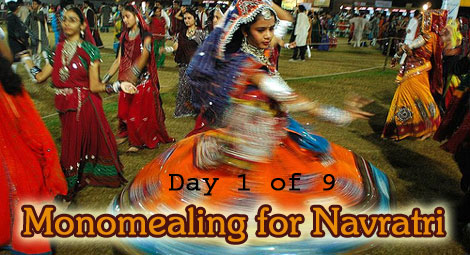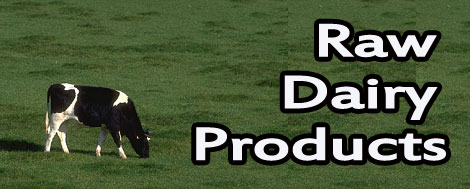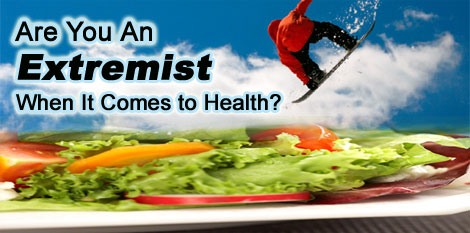
Today I'd like to do something different for Makin' It Monday. I'll tell you what we've eaten today, but I want to hear what's been happening in YOUR kitchen!
This morning I sliced up three bananas, drizzled them with some agave, sprinked a bit of Himalayan crystal salt on them, and then topped them with hemp seeds and sprouted flax seeds with cranberries and gogi berries. I love this breakfast because it feels like I'm eating something a bit complex and more filling than simply eating the bananas plain (which is how I almost always eat them). KDcat had a bowl of oatmeal (not raw), and Jim had a few pieces of fruit.
Read more: Makin' It Monday: What's Happening In YOUR Kitchen?

In this special five-part series, Joanna Steven uncovers where some top vegetarian athletes get their protein. Here's part two, focusing on Koya Webb's take on this issue.
ALMONDS
?The greater the percentage of raw food in the diet, the greater the health benefits? is Koya Webb, fitness model, personal trainer, triathlete and body builder's personal motto. Koya's sculpted physique won 1st place in the Ultimate Fitness Events "Fitness Model" and "Bikini Model" competitions and has modeled for Nike, Adidas, New Balance, Muscle and Fitness, Her Sports, Royal Caribbean and Triathlete magazine, to name a few. As a living-foodist (one who eats 60% or more uncooked veggies, nuts, seeds, and super foods) Koya believes eating all natural ?fruits of the earth? can help heal cancer, diabetes, and other diseases plaguing our society today.
Read more: Vegetarian Athletes Share: Top 5 Sources for Animal-free Protein (Part 2 of 5)

To help keep all of you inspired, we ve asked some
remarkable individuals to share their raw food stories with you. Enjoy!
I was sitting here today thinking about all of you, our lovely online friends who visit this blog. You follow what's going on with us, learn from us, find inspiration in the things we share, and even offer support to us in many ways.
Some of you reach out by leaving comments, many of you send emails, and a larger majority of you are quiet friends who haven't made contact with us, yet. Each and every one of you means so very much to me (and to Jim, too).
We don't keep this blog for ourselves; we keep it for all of you. It is our desire to share all that we've been through, and what we've learned, in order to help you with your own journey. Most of all, however, my personal desire is to inspire you to live the life you truly want to be living (in more ways than just through what you eat).

Jim here... Conventional wisdom says we shouldn't judge a book by its cover, right? Well, what about recipes? Should we judge them by their names?
When KDcat was young -- well before we followed a raw diet -- her friends sometimes scoffed at our typical vegan fare. After all, few kids would voluntarily eat "Pasta with Spinach Sauce."? But, we discovered, change the name and suddenly they're lining up for seconds. Instead of "Spinach Sauce," Wendi came up with "Jungle Sauce"! How exciting, right?

Happy Navratri!
DAY 1:

In this special five-part series, Joanna Steven uncovers where some top vegetarian athletes get their protein. Here's part five, focusing on Tonya Kay's take on this issue.
AVOCADO
Professional dance is of most challenging sports requiring athletes to perform at expert levels of flexibility, strength, coordination and emotional fitness in order to entertain their audiences. Having been vegetarian since age 7, Tonya Kay has built her glorious professional dance career entirely on a vegetarian diet.
Read more: Vegetarian Athletes Share: Top 5 Sources for Animal-free Protein (Part 5 of 5)
***** DISCLAIMER: As with all of our posts here at Pure Jeevan, and particularly those tagged with a new term, "Nadi Balance," please refer to the disclaimer that runs at the bottom of all Pure Jeevan pages. Wendi and Jim are health researchers, educators, and extreme self-experimenters; not doctors. ******

If you've been following this Nadi Balance series, you're probably as fascinated as we are with the body and the myriad ways in which we can peer into our physical health through observation and experimentation. Yesterday, we learned about a blanace being necessary in the human body between fatty acids and sterol fats. (This is but one of the many balances we'll eventually talk about under the larger umbrella of Nadi Balance.) We shared how Wendi's body was in an an extremely unbalanced state, with her fatty acids far outweighing the amount of sterol fats.

Wendi tells a funny story sometimes about a woman she'd met who was considering undergoing gastric bypass surgery to help her lose weight. When Wendi asked the woman whether she'd consider changing her diet to a raw foods regimen, she responded with something like, "Oh, no, that's too radical."
This is really what it's come to in society; having part of your digestive system surgically altered (in a profound, irreversible, dangerous, and invasive way) is no more than some nonchalant, consequence-free elective decision ... while eating more salads is viewed as "radical."
For the most part, I've been eating intuitively from the very start of my raw food journey (which began over two years ago!). I noticed that I was drawn to different foods for blocks of time, and as my interest would wane I'd find myself drawn to another raw food. Anyone who has followed my story to health knows about my love for young Thai coconuts. My entire body would vibrate with physical excitement every time I picked up another case of those life-enhancing baby coconuts. I felt like a child receiving a much-desired gift---giddy with excitement and unable to stand still. I'm not just saying that, either---it was a very strange sensation, feeling such excitement over a food.
Well, my love for the coconuts faded and I found myself drawn to other foods over the past few years. However, none of them ever compared in intensity to my desire for the coconut. I can't recall all of the foods I cycled through, but there were plenty of food cycles I went through. Currently, I'm intuitively drawn to the pineapple. I want to eat it at least once a day, sometimes more. I haven't tired of it in the least bit.

Continuing with our week of ways to keep a sharp mind, let's focus on the one widely accepted indicator for dementia or alzheimer's: heart disease. If one wants to dramatically reduce the chances of brain degredation, the first step to take is keeping the heart healthy.
The key advice most health specialists agree on when it comes to a healthy heart is the reduction (ideally eliminatain) of unhealthy fats in the diet. The unhealthy fats are usually seen as solid fats, like butter, margerine, and shortening. However, it's important to not overlook the fats that are also found in meats. By substituting unhealthy fats with something healthier for your heart (like extra virgin, cold-pressed olive oil), as well as transitioning to leaner meats if you are a meat eater, you will be taking some important steps in keeping your heart healthy, as well as your mind.

